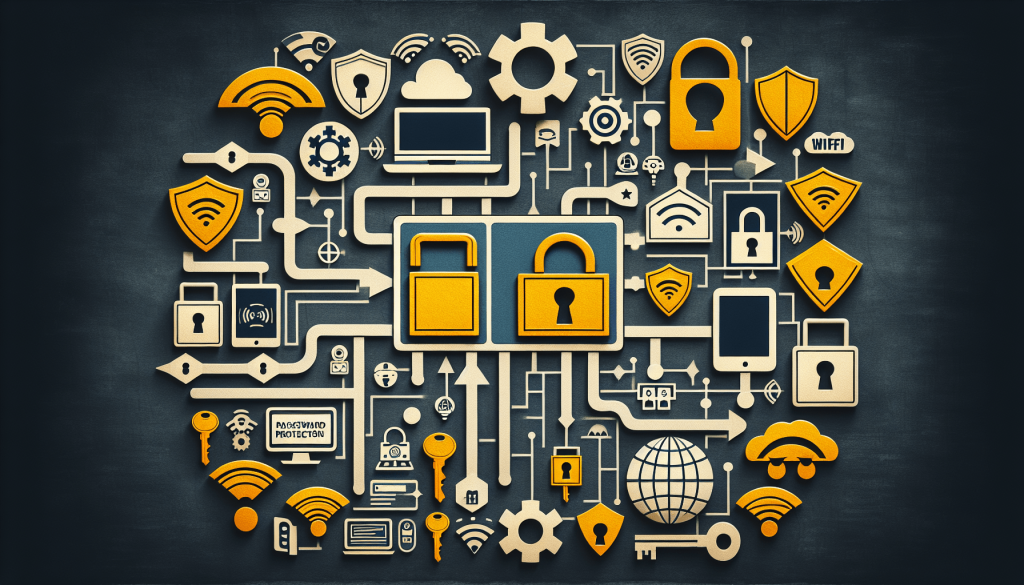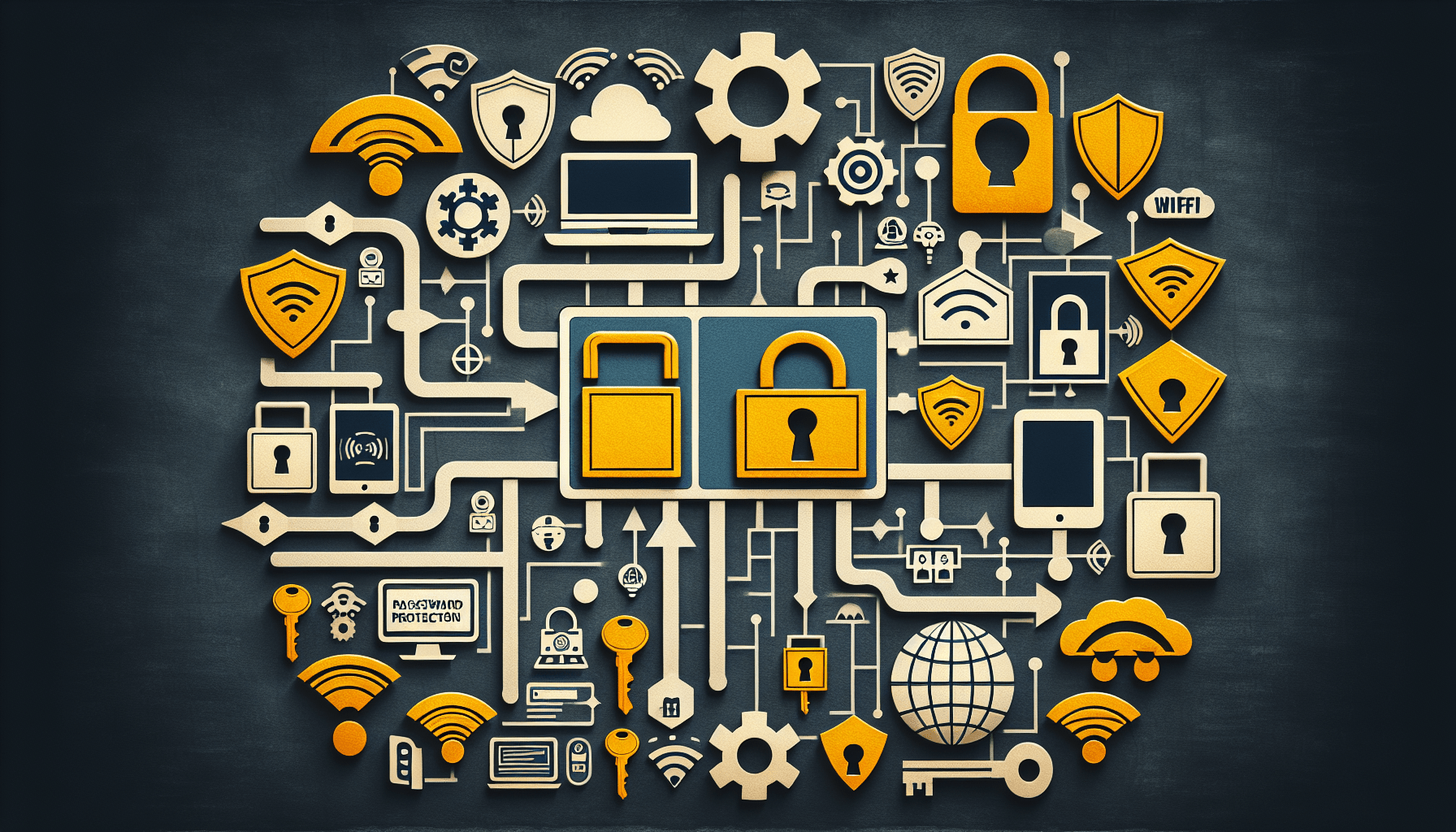In this article, you will discover the top ways to enhance the security of your wireless network. With the ever-increasing reliance on Wi-Fi for everyday tasks, it has never been more important to ensure the safety of your connection. From implementing strong passwords to enabling network encryption, this ultimate guide will provide you with practical tips and strategies to protect your wireless network from potential threats. Say goodbye to worries about unwanted intruders and hello to a more secure and reliable internet experience. So, let’s get started on enhancing your wireless network security!

Maintaining Strong Passwords
Create unique and complex passwords
One of the most important steps you can take to enhance the security of your wireless network is to create unique and complex passwords. Avoid using common passwords or personal information that can easily be guessed or obtained. Instead, opt for a combination of lowercase and uppercase letters, numbers, and special characters. The longer and more complex your password is, the harder it becomes for hackers to crack it. Remember to create separate passwords for different accounts and change them periodically for added security.
Enable two-factor authentication
Another effective way to fortify the security of your wireless network is to enable two-factor authentication. This adds an extra layer of protection by requiring a second verification step, usually via a text message or authentication app, in addition to entering your password. By implementing this feature, even if someone manages to get hold of your password, they won’t be able to access your network without the second factor of authentication.
Regularly change passwords
In addition to creating strong passwords and enabling two-factor authentication, it’s crucial to regularly change your passwords. This practice minimizes the risk of unauthorized access to your wireless network. Set reminders to change your passwords every few months, or whenever there is a suspected security breach. By regularly updating your passwords, you’ll stay one step ahead of potential attackers and ensure the continued security of your network.
Implementing Network Encryption
Enable WPA2 encryption
Enabling WPA2 (Wi-Fi Protected Access 2) encryption is an essential step in securing your wireless network. WPA2 provides advanced encryption protocols that make it difficult for unauthorized users to intercept and decode your network traffic. Unlike older encryption methods, WPA2 provides a higher level of security and is less susceptible to attacks. It’s important to ensure that your Wi-Fi access points and devices are configured to use WPA2 encryption to keep your network secure.
Disable outdated encryption protocols
To further enhance the security of your wireless network, it is essential to disable outdated encryption protocols. Older protocols, such as WEP (Wired Equivalent Privacy), are known to have vulnerabilities that can be exploited by hackers. By disabling these outdated protocols and relying solely on WPA2 encryption, you eliminate potential security risks and protect the integrity of your network.
Use strong encryption keys
In addition to enabling encryption protocols, it is crucial to use strong encryption keys for your wireless network. Encryption keys are used to secure the data transmitted over your network. Avoid using default encryption keys provided by manufacturers, as these are commonly known and can be easily bypassed by attackers. Instead, generate strong encryption keys comprising of a combination of letters, numbers, and special characters. The longer and more complex the encryption key, the more secure your network will be against unauthorized access.
Securing Wi-Fi Access Points
Change default login credentials
One of the simplest yet effective ways to secure your Wi-Fi access points is to change the default login credentials. Manufacturers often provide default usernames and passwords for convenient setup, but these are widely known and can be exploited by attackers. By changing the default login credentials, you prevent unauthorized individuals from accessing and tampering with your access points’ settings.
Disable remote administration
To further enhance the security of your Wi-Fi access points, it is recommended to disable remote administration. Remote administration allows you to manage your access points’ settings from a remote location, but it also opens up a potential vulnerability. By disabling this feature, you limit access to your access points’ settings to only those who have physical access to them, reducing the risk of unauthorized changes or attacks.
Turn off SSID broadcast
Another way to secure your Wi-Fi access points is to turn off SSID (Service Set Identifier) broadcast. SSID broadcast is the feature that makes your wireless network visible to other devices. By disabling this feature, your network becomes “hidden” and can only be accessed by devices that already know its name. While this does not provide foolproof security, it adds an additional layer of obscurity, deterring casual attempts at unauthorized access.
Using a Firewall
Install a hardware firewall
Installing a hardware firewall is crucial for protecting your wireless network from external threats. A hardware firewall acts as a barrier between your network and the internet, monitoring and filtering incoming and outgoing traffic. It acts as the first line of defense against unauthorized access attempts and malicious activities. By installing a reliable hardware firewall, you significantly reduce the risk of a successful attack on your network.
Activate software firewalls on connected devices
In addition to a hardware firewall, it is essential to activate software firewalls on all connected devices. Software firewalls provide an additional layer of protection by monitoring and controlling the incoming and outgoing traffic on each device. They can detect and block any suspicious or potentially harmful activity, preventing unauthorized access to your network. Ensure that the software firewalls on your devices are kept up to date with the latest security patches for optimal protection.
Regularly update firewall settings
To maintain the effectiveness of your firewall, it is crucial to regularly update its settings. Firewall manufacturers often release updates and patches to address newly discovered vulnerabilities or enhance security features. By keeping your firewall up to date, you ensure that it provides the highest level of protection against the latest threats. Stay vigilant and subscribe to alerts from the manufacturer to receive timely notifications about any essential updates or security patches.

Regular Updates and Patching
Keep firmware and software up to date
Keeping your firmware and software up to date is vital for maintaining a secure wireless network. Manufacturers regularly release updates and patches to address security vulnerabilities or improve the performance of their products. It’s important to regularly check for updates on your network devices and install them promptly. Outdated firmware and software can expose your network to potential attacks, so staying up to date is crucial for ensuring network security.
Apply security patches promptly
In addition to updating firmware and software, it is equally important to apply security patches promptly. Security patches are specific updates that address known vulnerabilities or weaknesses in your network devices. These vulnerabilities are often discovered by security researchers or reported by users. By applying security patches as soon as they become available, you mitigate the risk of exploitation by attackers and keep your network secure.
Subscribe to manufacturer alerts
To stay informed about the latest security updates and patches, it is recommended to subscribe to alerts from manufacturers. Most manufacturers provide the option to receive notifications via email or through their website. By subscribing to these alerts, you ensure that you are promptly notified of any critical updates or security vulnerabilities that may affect your network. Staying proactive and informed is key to maintaining a secure wireless network.
Monitoring Network Traffic
Utilize network monitoring tools
Monitoring network traffic is a crucial aspect of enhancing wireless network security. By utilizing network monitoring tools, you gain visibility into the devices and traffic on your network. These tools can help you identify any unusual or suspicious activity, such as unauthorized devices or excessive bandwidth usage. By regularly monitoring your network traffic, you can quickly detect and respond to any potential security breaches, ensuring the integrity and privacy of your network.
Look for suspicious activities and rogue devices
When monitoring network traffic, be on the lookout for any suspicious activities or rogue devices. These can be indicators of unauthorized access or attempts to infiltrate your network. Look for any unusual connections, unexpected data transfers, or devices that are not recognized or authorized. By investigating and addressing these potential threats promptly, you can prevent further compromise and safeguard your network.
Monitor bandwidth usage
Monitoring bandwidth usage is another important aspect of network traffic monitoring. Sudden or consistent spikes in bandwidth consumption can be a sign of unauthorized activities or malware on your network. By keeping an eye on your network’s bandwidth usage, you can identify any anomalies and take appropriate action to mitigate any potential threats. Monitoring bandwidth usage also helps optimize your network’s performance and ensures a smooth browsing experience for your users.
Implementing Network Segmentation
Separate devices into subnetworks
Implementing network segmentation involves separating devices into smaller subnetworks. This practice adds an extra layer of security by isolating different segments of your network. By dividing devices into subnetworks, you limit the reach of potential attacks and minimize the impact of any security breaches. For example, you can create separate subnetworks for devices with sensitive information or critical systems, ensuring that even if one segment is compromised, the rest of your network remains secure.
Use VLANs to restrict access
Virtual LANs (VLANs) are an effective way to restrict access within your network. VLANs allow you to group devices together based on specific criteria and control their communication with other devices or subnetworks. By using VLANs, you can enforce strict access policies, ensuring that only authorized devices can communicate with each other. This prevents unauthorized devices from accessing sensitive information or disrupting the operation of critical systems, enhancing the overall security of your network.
Implement access control lists
Access control lists (ACLs) are another valuable tool for network segmentation. ACLs allow you to define and enforce granular access policies for each device or subnetwork on your network. By specifying precisely which devices or services are allowed or denied access, you have greater control over the flow of traffic within your network. Implementing ACLs ensures that only authorized devices and services interact with each other, reducing the risk of unauthorized access or malicious activities.
Creating Guest Networks
Set up separate networks for guests
Creating separate networks for guests is an important security measure for protecting your main network. By setting up a dedicated guest network, you provide visitors with internet access while isolating their devices from your main network. This ensures that guest devices cannot interact with or access the devices and data on your primary network, significantly reducing the risk of unauthorized access or potential attacks.
Isolate guest traffic from the main network
In addition to setting up separate networks, it is crucial to isolate guest traffic from your main network. This can be achieved through the use of VLANs or network segmentation techniques. By isolating guest traffic, you prevent any potential compromise of guest devices from affecting the security and integrity of your primary network. Isolating guest traffic also helps to protect sensitive information, ensuring that it stays within the confines of your primary network.
Apply password and usage restrictions
To further enhance the security of your guest networks, it is important to apply password and usage restrictions. Set a strong password for your guest network, ensuring that it is different from the password used for your main network. Limit the duration of guest network access, forcing guests to reconnect periodically. By implementing these restrictions, you reduce the risk of unauthorized access and potential abuse of your guest network, promoting a more secure wireless environment.
Physical Security Measures
Control access to Wi-Fi equipment
Physical security measures are crucial for protecting your wireless network from unauthorized access. Controlling access to your Wi-Fi equipment, such as routers and access points, is a key aspect of physical security. Place your equipment in a secure location, such as a locked server room or cabinet, to prevent unauthorized individuals from tampering with or stealing your equipment. Limit access to only authorized personnel, ensuring that the physical security of your network devices is maintained.
Lock network cabinets
Locking network cabinets adds an additional layer of physical security to your wireless network. Network cabinets typically house various networking equipment, such as routers, switches, and patch panels. By securing these cabinets with locks, you prevent unauthorized access to the equipment and minimize the risk of tampering or theft. Ensure that only authorized individuals have access to the keys or combination, maintaining the integrity and security of your network infrastructure.
Restrict physical access to routers
The physical security of your routers is of utmost importance to protect your wireless network. Restricting physical access to your routers ensures that unauthorized individuals cannot tamper with or compromise these critical devices. Place your routers in a secure location, such as a locked room or cabinet, and ensure that only authorized individuals have access. By implementing these physical security measures, you fortify the overall security of your wireless network.
Regular Security Audits
Conduct penetration testing
Regular security audits, such as penetration testing, are essential for evaluating the effectiveness of your network security measures. Penetration testing involves simulated attacks on your network to identify vulnerabilities and weaknesses. By conducting these tests on a regular basis, you can proactively address any security gaps and ensure that your network is adequately protected. Engage with reputable cybersecurity professionals or companies to conduct thorough and comprehensive penetration testing on your wireless network.
Perform vulnerability assessments
In addition to penetration testing, vulnerability assessments provide valuable insights into the security posture of your wireless network. These assessments involve scanning your network for potential vulnerabilities and weaknesses. By identifying these vulnerabilities, you can take the necessary steps to address them before they are exploited by attackers. Regular vulnerability assessments help you stay ahead of emerging threats and maintain a secure wireless network environment.
Audit security policies
Lastly, regularly auditing your network’s security policies is crucial for ensuring ongoing network security. Review your existing security policies to identify any gaps or areas for improvement. Evaluate whether your policies align with best practices and industry standards. Make necessary updates or adjustments to address any new threats or changes in your network environment. By regularly auditing your security policies, you can adapt to evolving security challenges and maintain a robust wireless network defense.
In conclusion, enhancing the security of your wireless network requires proactive and comprehensive measures. By following the recommendations outlined in this article, such as creating strong passwords, implementing network encryption, securing Wi-Fi access points, using firewalls, performing regular updates, monitoring network traffic, implementing network segmentation, creating guest networks, employing physical security measures, and conducting regular security audits, you can significantly fortify the security of your wireless network. Remember, maintaining strong network security is an ongoing process, and it’s essential to stay informed about emerging threats and adopt new security measures as needed. With the right approach and practices, you can create a secure wireless network environment for yourself and your users.
